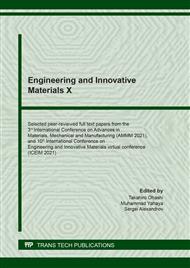[1]
B.A. Baum, Metal liquids, Nauka, Moscow, (1979).
Google Scholar
[2]
L. Goumiri, J.C. Joud, Average atomic order effect – prediction of bulk and surface properties of liquid metallic systems, Surf. Sci. 138 (1984) 524–548.
DOI: 10.1016/0039-6028(84)90263-2
Google Scholar
[3]
O,G. Shpyrko, R. Streitel V.S.K. Balagurusamy, A.Y. Grigoriev, M. Deutsch, B.M. Ocko, M. Meron, B. Lin, P.S. Pershan, Surface crystallization in a liquid AuSi alloy, Science 313 (2006) 77–80.
DOI: 10.1126/science.1128314
Google Scholar
[4]
S.I. Popel, Surface phenomena in melts, Metallurgiya, Moscow, (1994).
Google Scholar
[5]
I. Egry, E. Ricci, R. Novakovic, S. Ozawa, Surface tension of liquids metals and alloys – recent developments, Adv. Colloid Interface Sci. 159 (2010) 198–212.
DOI: 10.1016/j.cis.2010.06.009
Google Scholar
[6]
A.V. Ruban, On segregation in multicomponent alloys: surface segregation in austenite and FeCrCoNiMn alloys, Comp. Mater. Sci. 187 (2021) 110080.
DOI: 10.1016/j.commatsci.2020.110080
Google Scholar
[7]
H. Tanaka, General view of a liquid-liquid phase transition, Phys. Rev. E62 (2000)6968-6976.
DOI: 10.1103/physreve.62.6968
Google Scholar
[8]
Y. He, J. Li, J. Wang, H. Kou, E. Beagunon, Liquid-liquid structure transition and nucleation in undercooled Co-B eutectic alloys, Appl. Phys. A 123 (2017) 391.
DOI: 10.1007/s00339-017-0984-4
Google Scholar
[9]
V. Tsepelev, Yu. Starodubtsev, V. Konashkov, K. Wu, R. Wang, Melt viscosity of nanocrystalline alloys in the model of free volume, J. Alloys Comp. 790 (2019) 547–550.
DOI: 10.1016/j.jallcom.2019.03.106
Google Scholar
[10]
I. Egry, On a universal relation between surface tension and viscosity, Scr. Metall. Mater. 26 (1992) 1349–1352.
DOI: 10.1016/0956-716x(92)90647-w
Google Scholar
[11]
V.S. Tsepelev, Yu.N. Starodubtsev, Nanocrystalline soft magnetic iron-based materials from liquid state to ready product. Nanomatarials, 11 (2021) 00108.
DOI: 10.3390/nano11010108
Google Scholar
[12]
V. Tsepelev, V. Konashkov, Y. Starodubtsev, Y. Belozerov, D. Gaipisherov, Optimum regime of heat treatment of soft magnetic amorphous materials, IEEE Trans. Magn. 48 (2012) 1327–1330.
DOI: 10.1109/tmag.2011.2175209
Google Scholar
[13]
X. Zhao, C. Wang, H. Zheng, Z. Tian, L. Hu, The role of liquid-liquid transition in glass formation of CuZr alloys, Phys. Chem. Chem. Phys. 19 (2018) 15962–15972.
DOI: 10.1039/c7cp02111a
Google Scholar
[14]
S. Glasstone, K. Laidler, H. Eyring, The theory of rate processes. The kinetics of chemical reactions, viscosity, diffusion and electrochemical phenomena; McGraw Hill, New York, (1941).
Google Scholar
[15]
E.D. Alvares, W.J. Botta, J. Ågren, A. Costa e Silva, An assessment of Fe-Nb-B melts using the two-stage liquid model, Calphad 68 (2020) 101692.
DOI: 10.1016/j.calphad.2019.101692
Google Scholar
[16]
K. Yoshitomi, Y. Nakama, H. Ohtani, M. Hasebe, Thermodynamic analysis of the Fe-Nb-B ternary system, ISIJ International 48 (2008) 835–844.
DOI: 10.2355/isijinternational.48.835
Google Scholar
[17]
M. Nakamoto, T. Tanaka, Estimation of activity coefficient of solute in infinite dilute liquid iron based on surface tension of binary Fe alloys, ISIJ International 60 (2020) 2141–2146.
DOI: 10.2355/isijinternational.isijint-2019-796
Google Scholar
[18]
M. Tomut, H. Chiriac, M. Marinescu, F. Necula, Viscosity and surface tension measurements on Fe-rich FeB liquid alloys, J. Non-Cryst. Solids 250–252 (1999) 655–659.
DOI: 10.1016/s0022-3093(99)00153-2
Google Scholar
[19]
S.V. Lukin, V.I Zhuchkov, N.A. Vatolin, The surface tension, density and oxidation kinetics of Fe-Si-B alloys, J. Less-Common Met. 67 (1979) 399–405.
DOI: 10.1016/0022-5088(79)90018-3
Google Scholar
[20]
A.V. Ruban, H.L. Skriver, J.K. Nørskov, Surface segregation energy in transition-metal alloys, Phys. Rev. B 59 (1999) 15990–16000.
DOI: 10.1103/physrevb.59.15990
Google Scholar
[21]
R.E. Honig, D.A. Kramer Vapor pressure data for the solid and liquid elements, RCA Rev. 30 (1969) 285–305.
Google Scholar


